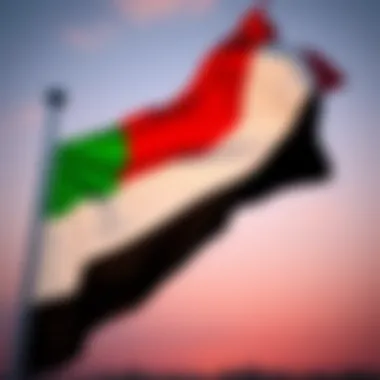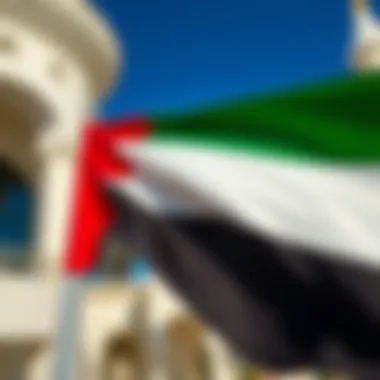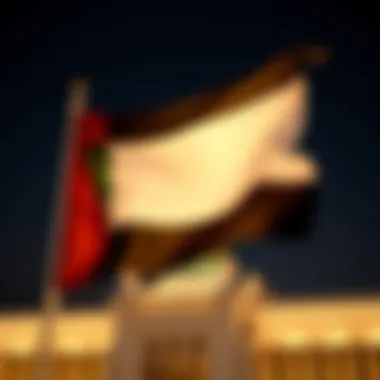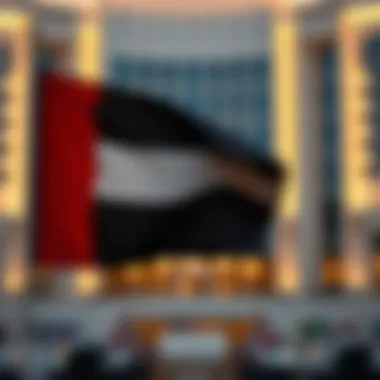Exploring the Symbolism of the UAE Flag


Intro
The flag of the United Arab Emirates is a vivid tapestry of colors, each carrying profound meaning and historical context. It stands not just as a mere piece of cloth; it embodies the spirit and unity of the nation. With its striking green, white, black, and red, the flag reflects an intricate blend of tradition and modernity, showcasing the values held dear by the Emirati people.
Understanding this flag requires more than a surface glance. It’s essential to delve into its origins, the design elements, and what these colors symbolize. The flag's relevance extends beyond national pride; it plays a pivotal role in shaping identity, fostering unity, and representing the cultural ethos of the UAE.
As the UAE continues to evolve on the global stage, the flag remains a steadfast symbol of its heritage and aspirations. In this article, we will unravel the layers of meaning behind the flag, exploring how each color narrates a story of resilience, hope, and community.
Prelims to the UAE Flag
The flag of the United Arab Emirates is more than just a piece of fabric flapping in the wind; it is a potent emblem steeped in meaning and history. Understanding the flag helps to grasp the essence of the nation itself — its unique heritage, aspirations, and collective identity. This section tackles the flag’s rich backdrop, diving into its historical significance and eventual adoption, setting the stage for a deeper examination of its design elements and cultural importance.
Historical Overview
The journey of the UAE flag dates back to the early days of the federation. Before the unification of the emirates in 1971, each emirate had its own flag, which varied considerably in design and color. However, with the formation of the UAE, there was a need for a unified national symbol that could reflect harmony among the diverse cultures and traditions of its seven emirates.
On December 2, 1971, the UAE flag was officially adopted, coinciding with the nation’s formation as a sovereign state. The flag was designed by Abdullah Mohammed Al Maainah, who was inspired by the colors of the banners used by Arab nations throughout history. This historical context is vital, as it illustrates not only a shift towards unity but also a collective aspiration towards a shared identity that resonates across the varied landscapes and traditions of the UAE.
Adoption of the Flag
The adoption of the flag came at a crucial time in the UAE’s history, marking a significant milestone in the establishment of national pride. December 2 is celebrated annually as Flag Day, a day when citizens and residents pay homage to this symbol of unity. From government buildings to private homes, the flag is proudly displayed, embodying both the spirit of the nation and the aspirations of its people.
Design Elements of the Flag
The design elements of the United Arab Emirates flag carry immense significance. They provide a visual representation of the nation’s values and identity. Understanding these elements not only enhances appreciation for the flag itself but also for the culture and heritage of the UAE. Each component—color, proportions, and layout—brings a unique dimension to the flag's overall impact.
Color Scheme
The color scheme of the UAE flag is striking yet simple, comprising four primary colors: red, green, white, and black. Each color plays its part in communicating the message inherent within the flag. The use of these colors is no stroke of luck; their selection is steeped in historical meaning.
- Red symbolizes bravery and resilience. It reflects a spirit of courage, serving as a reminder of the sacrifices made by the nation’s forefathers.
- Green stands for hope, fertility, and prosperity. It alludes to the lush landscapes that contrast with the arid desert region.
- White embodies peace and purity. This color indicates the desire for harmony in the region and among its citizens.
- Black signifies strength and determination. It hints at the resilience of the people in the face of adversity.
When these colors are combined, they tell a story that resonates deeply with the people of the UAE, bridging past and present.
Proportions and Layout
The proportions and layout of the UAE flag are equally noteworthy. The flag's design follows a ratio of 1:2, meaning its height is half the length. This straightforward geometric structure symbolizes balance and unity—two essential tenets in the Emirati culture. The design features three horizontal stripes of green, white, and black from top to bottom, with a vertical red band on the left side.


The positioning of the red band captures attention first, perhaps indicative of the nation's bold nature. Each of the horizontal colors meets at a clean intersection, suggesting collaborative cohesion among the emirates, while the red stands steadfast on the left, symbolizing the united strength of the nation.
Symbolism of Each Color
The symbolism attributed to each color within the flag deepens our understanding of what the flag represents. The interpretations drawn from this symbolism play a vital role in shaping the national narrative.
- Red denotes not just bravery but also a fierce service to the country.
- Green, often linked to fertile lands, represents hope for the future, intertwined with a commitment to social welfare.
- White has connotations with honesty and fairness, reinforcing values that the UAE seeks to live by.
- Black, while it may represent a stoic nature, also conveys the strength found in unity amid diversity.
"A flag is more than just a piece of cloth; it is a tapestry woven with stories, values, and dreams of a nation."
For further reading on the significance of national symbols, you can visit Wikipedia and Britannica.
Cultural Significance
The cultural significance of the flag of the United Arab Emirates transcends its physical presence, embodying the spirit and identity of the nation. It serves as a pivotal symbol that promotes awareness and appreciation of the rich tapestry of cultures, history, and values that define the UAE. Not only does it represent a commitment to unity, but it also acts as a tangible reminder of the milestones achieved since the formation of the federation in 1971.
National Identity
The colors of the UAE flag—red, green, white, and black—aren't just decorative but rather deeply rooted in the Arab heritage. Red signifies bravery and strength, while green symbolizes hope and prosperity. White is often associated with peace and honesty, and black represents the strength and resilience of the nation against adversity. This combination acts as a powerful emblem of national pride.
For Emiratis, the flag is displayed prominently during national celebrations, fostering a sense of belonging. Schools and institutions incorporate flag education into their curricula, helping younger generations understand its symbolism. In this light, the flag becomes a vehicle for instilling values of patriotism and connection to one’s roots, essential in today's fast-paced world.
Unity Among Emirates
When one looks closely at the flag, it is apparent that it symbolizes the unity of seven emirates—Abu Dhabi, Dubai, Sharjah, Ajman, Umm Al-Quwain, Fujairah, and Ras Al Khaimah. Each emirate retains its unique culture and customs, but together they form a stronger identity. The flag serves as a graphic representation of this unity, reminding citizens that despite any differences, they are part of a larger whole.
Furthermore, various celebrations like the National Day and Flag Day not only highlight the flag but also reinforce the sense of brotherhood and cooperation among the emirates. The diverse cultural practices and traditions within each emirate are embraced, collectively strengthening the national identity.
Celebration of Heritage
The flag acts as a catalyst for celebrating heritage. It is not uncommon to see it in art exhibitions or cultural festivals, where artisans and performers showcase traditional crafts, music, and dance. These events highlight the history and narratives of the nation, invigorating the past while looking toward the future.
Community gatherings often feature the flag as a centerpiece, uniting individuals from different backgrounds to share stories and traditions. Each event fosters respect and encourages dialogue about the land's rich heritage. Thus, the flag becomes a living symbol, not just a piece of fabric but a reflection of the UAE's enduring legacy and its aspirations for coming generations.
"The flag is the foremost symbol of our identity and unity as a nation, embodying the values we cherish and the heritage we proudly celebrate."
In summary, the flag of the UAE conveys cultural significance far beyond its colors and design. It intertwines the notions of national identity, unity, and heritage, playing a critical role in shaping the narrative of a progressive yet tradition-rich society.


Political Context
The political landscape of the United Arab Emirates is intricate, shaped by its unique history and the current dynamics of the region. Understanding the political context surrounding the UAE flag provides insight into how symbols resonate within the society, especially among investors, expatriates, and local entrepreneurs. The national flag stands as a potent emblem of the identity and aspirations of the UAE, influencing both domestic policies and international relations.
Role in Diplomacy
The UAE flag plays a pivotal role in diplomatic settings, serving not only as a marker of the nation’s identity but also as a crucial tool in fostering international relations. When the flag is displayed at embassies, international conferences, and cultural exchanges, it represents the country's values and objectives. The importance of this representation cannot be understated.
The flag is more than just fabric; it conveys messages of unity, peace, and collaboration. For example, during high-profile meetings, the presence of the UAE flag sends a clear signal of the country's commitment to uphold its interests while welcoming global partnerships. The sight of the flag evokes a sense of pride and authority, influencing the perception others have of the UAE.
Moreover, the flag is often used in international humanitarian efforts, which further enhances the UAE's image abroad. By aligning the flag with initiatives aimed at helping others, the UAE demonstrates a willingness to engage positively on the global stage. Countries are more likely to align with a nation that exhibits a positive ethos through its symbols.
Symbol of Sovereignty
The flag also serves as a fundamental symbol of sovereignty. It encapsulates the historical journey of the UAE from a collection of individual emirates to a united federation. Each color and design element of the flag reflects the underlying principles of autonomy and strength, representing a commitment to maintain its independence while navigating the complexities of international governance.
The UAE flag stands proud, especially during national events and international gatherings, acting as a firm reminder of the nation’s sovereignty. When citizens and residents see the flag, it instills a sense of belonging and pride, reinforcing their loyalty to the country. The flag becomes a visual representation of the collective aspirations of the people and the government.
"A flag doesn’t just fly; it tells a story through its colors and symbols, resonating deeply with its people."
For further insights on the history and significance of the UAE flag, you may find valuable information at en.wikipedia.org or britannica.com.
Education and Awareness
Education and awareness concerning the UAE flag play a crucial role in ensuring that the symbol is treated with reverence and understood in its full context. Participating in flag educational initiatives can nourish deeper connections among residents and foster a collective identity. This process is particularly important in a diverse nation such as the UAE, where numerous cultures nestle together, each with their own histories and values. The flag represents more than just fabric and color; it encapsulates the ethos of the country, its resilience, and aspirations.
Integrating Flag Studies in Schools
Introducing flag studies into the academic curriculum can help children grasp the importance of their national emblem. Such education can occur at various levels—starting from elementary schools, where students could learn about the flag’s design, its historical background, and the ethos it embodies. Engaging students in activities like drawing the flag or writing essays on what it symbolizes can inspire personal connection and pride.
- In-Class Projects: Schools can implement projects where students research the UAE's history or create their own interpretations of the flag, encouraging creative expression.
- Interactive Assemblies: Schools might hold assemblies on national holidays where the flag's significance is explained to the entire student body, lending it prominence.
- Cultural Exchange Programs: Schools can work together on cultural projects with institutions from other countries to share banners and symbols, comparing meanings and values in education.
By integrating such studies, students learn not just the mechanics behind the design but also the stories attached to it, nurturing a sense of national pride and belonging.
Promoting Patriotism through Flag Appreciation
Flag appreciation can serve as a powerful conduit for patriotism. Events that honor the flag—like Flag Day—should not merely be an exercise in formalities but rather celebrations that echo the spirit of the nation. Folks can engage in parades and public gatherings featuring the flag prominently to instill a sense of unity.


- Community Events: Local municipalities can organize events encouraging citizens to celebrate by wearing colors representing the flag, creating a visual display of solidarity.
- Social Media Campaigns: Utilizing platforms like Facebook and Instagram, community members can share personal photographs or reflections on what the flag means to them. These digital narratives can spark discussions about identity and patriotism.
- Educational Workshops: Workshops can emphasize why the flag deserves respect, teaching participants about the ceremonial aspects of flag handling and display, thus ensuring it's treated with dignity.
"A flag is not just a piece of cloth; it is a promise of loyalty, resilience, and pride for the people it represents."
In effectively promoting understanding and appreciation of the flag, education plays a vital part in voicing the values and culture of the UAE, ensuring that every citizen and resident honors this significant symbol.
Flag Etiquette and Display
Flag etiquette is a crucial anchor in the maritime and national identity of a country. For the United Arab Emirates, the flag embodies not just a symbol of sovereignty but also the values and principles that unite its citizens in a shared sense of pride. Understanding proper flag display methods and ways of respecting the flag in various situations can deepen one’s connection to the UAE and its heritage.
Proper Methods of Displaying the Flag
Displaying the UAE flag should be approached with a certain reverence. When placed in various contexts, whether at homes, businesses, or during national events, it’s important to follow established guidelines to honor the national emblem. Here are some essential considerations for proper flag display:
- Positioning: The flag should always be hoisted above other flags and should be raised briskly and lowered ceremoniously. It should be positioned in a place where it is well visible and respected—typically at a height higher than surrounding objects.
- Timeframe: The flag can be displayed from sunrise to sunset. If it is to be displayed at night, appropriate lighting must be provided to keep it visible.
- Condition: The flag should always be kept in good condition. If it is worn, torn, or faded, it may need to be replaced. A damaged flag can be viewed as a sign of disrespect.
- Special Events: During national holidays and observances, such as Flag Day or UAE National Day, it becomes even more crucial to display the flag prominently. Communities often come together in ceremonies to celebrate the flag.
By adhering to these guidelines, individuals and businesses demonstrate a commitment to the ideals and unity that the flag represents.
Respecting the Flag in Various Situations
Respecting the flag goes beyond just how it is displayed. It's essential to appreciate its significance and the emotions associated with it across different contexts. Here’s what you should keep in mind:
- Noble Handling: If you are to carry the flag, do it with care. Avoid letting it touch the ground or be used in any way that might diminish its dignity.
- Ceremonial Occasions: During formal events, bows or salutes may be given when the flag passes, a gesture showing respect. This is a practice observed during parades, gatherings, and other significant occasions.
- Communal Conduct: In public settings, when the national anthem is played, standing at attention while facing the flag is a potent display of respect. It fosters uniformity among attendees and reinforces national pride.
"The flag is a binding element, tying together diverse populations under a single identity. By showing respect to it, we honor our differences as much as our commonalities."
Understanding the aspects of flag etiquette and respect is more than just rules and guidelines. It's about fostering a culture that recognizes the flag as a significant relic of national unity, something that should be cherished and upheld in every situation.
Ending
In wrapping up our exploration of the UAE flag, it becomes abundantly clear that this emblem is more than just a piece of fabric that flutters in the wind. It stands as a beacon of national pride, encapsulating the essence of a country that has rapidly evolved into a global hub. The flag's significance is woven deeply into the very fabric of Emirati identity and history.
Summary of Key Points
- Historical Roots: The flag serves as a reminder of the UAE's journey towards unity and independence. Each color and design element has a historical backdrop, reflecting the trials and triumphs of its people.
- Cultural Significance: The flag is a symbol that resonates with every Emirati. It is not merely a national emblem but a source of unity among the seven emirates, fostering a sense of belonging and communal pride.
- Educational Role: Flag studies are woven into educational curriculums, ensuring that younger generations appreciate their heritage and take pride in their nationality.
- Political Context: Through its representation in diplomacy and international relations, the flag is both a sign of sovereignty and a tool for fostering ties with other nations.
In sum, the UAE flag is a confluence of history, culture, and politics—a vibrant testament to the past that bridges into the future. Understanding the layers of significance behind its colors and design can enrich personal connections to the Emirates for both residents and expatriates alike.
Encouraging Future Engagement with the Flag
As we look ahead, it is essential to cultivate an appreciation for the flag beyond mere observance. Engagement can take many forms—from participating in national celebrations to integrating discussions around the flag's symbolism in community events. Here are a few avenues for deeper engagement:
- Host Flag Appreciation Days: Educational institutions and community groups can organize events centered on the history and meaning of the UAE flag. This initiative can create a forum for dialogue among different generations.
- Celebrate National Days: National days are an ideal time to display the flag proudly. Encourage participation from all corners of society, showcasing diverse expressions of patriotism.
- Promote Creativity: Art competitions focusing on the flag’s symbolism allow individuals to express their understanding and admiration creatively.
- Connect Online: Encourage discussions on online platforms about the flag’s importance. Share personal stories or reflections that connect individuals with the fabric of the nation.
Involving oneself with the flag fosters a culture of respect and recognition of what it represents. As investors, expatriates, realtors, and entrepreneurs, understanding this symbol enriches not only personal identity but also boosts community spirit within the emirates. Thus, engaging with the UAE flag can serve as a catalyst for broader conversations about national commitment and identity, inviting both admiration and respect from a global audience.



